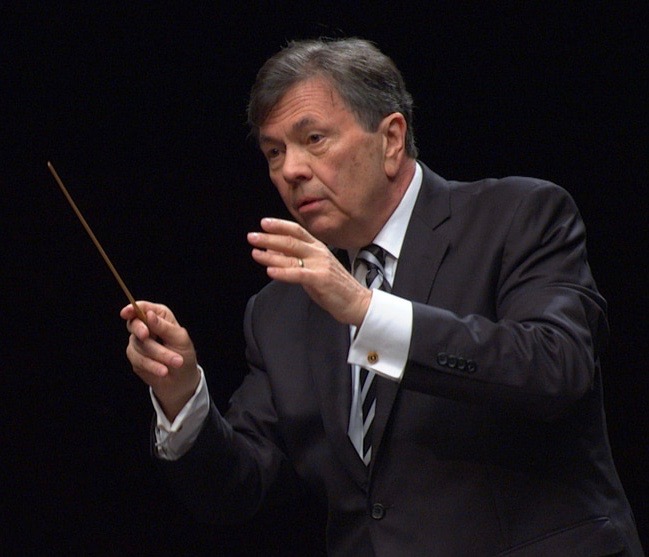Schwarz, Frost Symphony serve up Mozart, Still and Beethoven in season opener
Musical conservatories and educational institutions have had to adapt and innovate in the Covid 19 era in order to fulfill their mission. The University of Miami’s Frost School of Music has combined classroom and online learning with livestreamed performances presented before small, socially distanced audience.
On Saturday night, nearly 75 students and faculty members greeted conductor Gerard Schwarz and members of the Frost Symphony Orchestra at UM Gusman Concert Hall. For a critic who has not experienced live music since March, the event was doubly welcome. As usual Schwarz did not disappoint, spotlighting a rarely played work by a significant American composer and leading energetic readings of repertoire staples. (All the musicians and the conductor wore masks, except for the wind and brass players.)
William Grant Still was one of the first major African-American composers to write classical music. He penned over 200 works in virtually every musical medium and form. Darker America, a 12-minute tone poem written in 1924, combines elements of blues and jazz with the uplift of spirituals and sacred hymns. Still’s finely crafted score features introspective solo passages for winds and an active piano line, suggesting his early work as an arranger for big bands and Broadway.
Schwarz commanded tight ensemble and superbly controlled the tricky changes of meter. Even with one player to a stand and the musicians spread out across the stage, he managed to meld a cohesive corporate sonority. String textures were rich and the brass climaxes emerged with visceral impact. Still’s catalogue deserves further investigation and revival, particularly his later more austere efforts.
Mozart’s Symphony No. 41 in C Major (“Jupiter”) actually benefited from the distanced staging, allowing Schwarz to bring out inner details and scoring felicities of Mozart’s writing that can often be obscured. This was big, bold Mozart, played with vigor. Schwarz captured the darkness and drama beneath the graceful surface of the Andante cantabile and highlighted the dialogues between strings and winds with a winning touch. There was sinew as well as robust articulation in the finale and the extraordinary coda in which five themes are sounded simultaneously emerged clear and transparent under Schwarz’s lithe direction. Except for a brief wind slip near the end of the Menuetto, the student players were consistently secure and precise.
Schwarz’s strongly characterized Mozart suggested the Romanticism of Beethoven to come and, following intermission, three student soloists joined the players for Beethoven’s Triple Concerto. This work is not top-drawer Beethoven but the conception of a joint concerto for violin, cello and piano was unique and pioneering. A strong performance of this opus requires instrumental dexterity and the intimacy and well- attuned communication of a top flight chamber music group. The three student soloists managed to fulfill most of Beethoven’s challenges in supple fashion, a tribute to their ability and seriousness of purpose and their teachers’ careful preparation. ’s singing violin tone and cellist Tadao Hermida’s keenly perceptive and sensitive shaping of thematic lines blended warmly in duo passages. Priscila Navarro displayed a svelte touch in the keyboard lines but could summon power for Beethoven thorny pianistic drama. The coda of the first movement can easily fall apart but Schwarz and the three players deftly navigated that minefield.
The noble melody of the brief Largo offers a flash of inspired Beethoven and Hermida shaped it eloquently, his compact sound dominant without overwhelming his colleagues. Schwarz managed the transition to the finale seamlessly and instilled dance-like propulsion to the polonaise theme. Baird’s pinpoint accuracy and Hermida and Navarro’s articulation managed to infuse the repetitious iteration of the principal motif with energy and subtle variation. With around 40 players on stage, including six basses, Schwarz drew vital, incisive playing and made the best case for this problematic score. An enthusiastic standing ovation heralded the triumph of art over difficult circumstances.
Saturday’s Frost Symphony Orchestra concert is available for free viewing on YouTube.
Gerard Schwarz conducts the Frost Symphony Orchestra in Alvin Singleton’s After Choice, Debussy’s Prelude to the Afternoon of a Faun, Copland’s Appalachian Spring Suite and Hindemith’s Concert Music for Strings and Brass 7:30 p.m. November 20. The concert will be livestreamed on YouTube. music.miami.edu
Posted in Performances
2 Responses to “Schwarz, Frost Symphony serve up Mozart, Still and Beethoven in season opener”
Leave a Comment
Sun Oct 25, 2020
at 1:55 pm
2 Comments

Posted Oct 26, 2020 at 10:15 am by Misa Ito
Hello, I just want to thank you for writing this wonderful critic. I am Tadao Hermida Ito’s mother who played as one of the soloists. We live in Mexico y could not go to his concert because of the pandemic restriction. It is so nice to know about how it went. Thank you again.
Posted Oct 26, 2020 at 4:23 pm by David Lieberman
I haven’t read one of your reviews in a number of years and very much enjoyed seeing you in print again. Your writing really helps me understand the musice. I look forward to viewing this concert on You Tube.